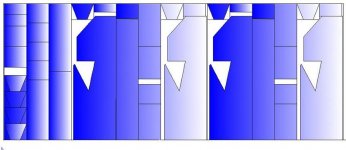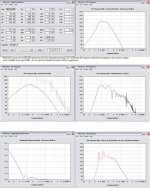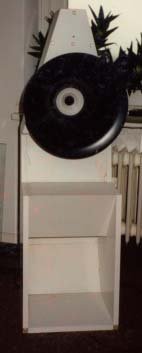Hello,
a very big satellite, you will need a lot of bass below 70 Hz.
Tell us how it sounds, if ready.
a very big satellite, you will need a lot of bass below 70 Hz.
Tell us how it sounds, if ready.
They will probably sound best with a sub, but there is more than enough excursion left down to 50hz that a little EQ or Bass knob will do wonders for the bass.
Very interesting,
there are several people here that have this driver and unfortunately very few cabinet options specifically designed for it... super large magnet and TS parameters. I like that this one the horn opens in the front.
please do post here any updates.
thank you
Paba
there are several people here that have this driver and unfortunately very few cabinet options specifically designed for it... super large magnet and TS parameters. I like that this one the horn opens in the front.
please do post here any updates.
thank you
Paba
Hello,
is the front horn throat smaller than the membran area?
if so the bass "never" reach the mids above 200 Hz,
aren´t you afraid of strong colourations by such a small
throat, and light weight membran?
may be high SPL, but the sound?
I made this 1985, and was not satisfied.
is the front horn throat smaller than the membran area?
if so the bass "never" reach the mids above 200 Hz,
aren´t you afraid of strong colourations by such a small
throat, and light weight membran?
may be high SPL, but the sound?
I made this 1985, and was not satisfied.
Attachments
The effect your talking about is from cancelations between the front and rear horns. Because your front horn is so big it's response goes much lower and cancels out the upper bass from the rear horn, because they are out of phase. I remodeled this several times to minimize that effect. You can still see a dip where the two horns "crossover" but it is not severe and ends up being less pronounced in reality than it is in simulation. Careful design is necessary to avoid this effect but it can be minimized and I believe I have done that in this design.
the middle row of charts shows the response of both horns working together. The one on the right doesn't look really impressive by itself but when you consider that hornresp doesn't model the high frequencies of the driver correctly because it assumes a flat plane insted of a cone with a whizzer. If you look at how it plots the high frequencies in an open baffle compaired to how it plots it in the horn (middle left) you get a pretty good idea what it does for the high frequencies. As you can see by the plot it's bringing the spl up pretty evenly all the way up and if the true response of the driver is relatively flat then the response of the driver in the horn will be as well. This sounds like a leap of faith but we've done it several times and have found this to be quite true.
this design reminds me of the beauhorn virtuoso with front firing blh. do you think it would be optimal to router a circular rebate for fitting the plastic ring at the edge of the surround on the front of the fostex drivers frame in order to create a tighter passage for the fh's air flow? also could the blh be made somewhat wider to bring the usable bass down to ~45hz-50hz without the help of a eq etc. yet still meshing with the fh fq res?as soon as I get some time I'm gonna figure out all the angles on all the cuts.
i'd like to see the updates when they're ready.
have there been any update of the plans, i.e. slightly larger for more bass and measurements/cut angles?
- Status
- Not open for further replies.
- Home
- Loudspeakers
- Full Range
- Compound horn for FE166ES-R FULL PLANS



